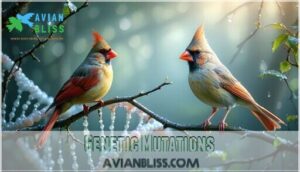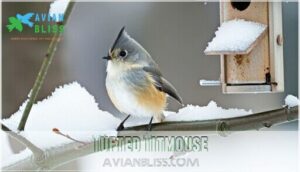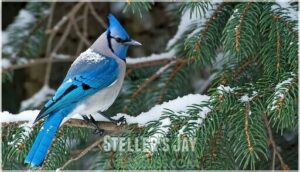This site is supported by our readers. We may earn a commission, at no cost to you, if you purchase through links.

You’re probably thinking of other blue birds that look similar from a distance. True cardinals only come in red, brown, and occasionally yellow or white due to rare genetic mutations.
The confusion happens because several blue birds share cardinal-like features – think indigo buntings, blue grosbeaks, or Steller’s jays. These birds can fool your eye, especially when they’re perched at bird feeders.
Cardinals get their red color from carotenoids in their diet, but blue pigment simply doesn’t exist in their genetic makeup. The real story behind these cardinal look-alikes reveals fascinating secrets about bird identification.
Table Of Contents
- Key Takeaways
- Blue Cardinal Myth
- Are Blue Cardinals Real
- Cardinal Color Variations
- Birds Mistaken for Blue Cardinals
- Attracting Cardinals to Your Yard
- Frequently Asked Questions (FAQs)
- What are some tips for attracting cardinals to your backyard?
- What is the lifespan of a cardinal?
- How has habitat loss affected cardinal populations?
- What are the best binoculars to use for birdwatching cardinals?
- What sounds do blue-colored birds make?
- When do cardinal breeding seasons occur?
- How long do cardinals typically live?
- Where do cardinals build their nests?
- Can cardinals hybridize with other species?
- Conclusion
Key Takeaways
- You won’t find blue cardinals in nature – they simply don’t exist despite decades of reported sightings, as cardinals lack the genetic ability to produce blue pigmentation.
- You’re likely seeing blue-colored birds like Blue Jays, Indigo Buntings, or Blue Grosbeaks that share similar features with cardinals, creating common misidentification at backyard feeders.
- You can spot real cardinal color variations including rare yellow and white birds caused by genetic mutations, but blue remains genetically impossible since cardinals only produce red colors through carotenoids.
- You’ll attract actual red cardinals to your yard by providing sunflower seeds in platform feeders, fresh water sources, and dense shrubs for nesting and protection.
Blue Cardinal Myth
You’ve probably heard someone claim they spotted a brilliant blue cardinal at their backyard feeder, but here’s the truth: blue cardinals don’t exist in nature.
Despite decades of reported sightings, blue cardinals remain a beautiful myth—nature simply doesn’t paint these birds in azure hues.
What you’re likely seeing are other blue-colored birds like Blue Jays, Indigo Buntings, or Blue Grosbeaks that share similar shapes and feeding habits with cardinals, which can be a likely cause of the confusion.
Bird Species Resembling Cardinals
Several bird species share similar bird traits with cardinal birds, making bird identification tricky.
You’ll notice habitat overlap between cardinals and blue-colored birds in your backyard.
Size comparisons reveal most are comparable to cardinals, while crest variations create visual confusion.
Their feeding habits at the same feeders add to misidentification.
No true blue cardinal exists among these bird species despite their bird colors.
Similarities With Blue Jays
When you spot crested heads at your birdfeeder, you might wonder if that’s actually a blue cardinal.
Blue Jays share remarkable similarities with Northern cardinals – both are backyard visitors with prominent crests who create birdfeeder competition.
Their shared habitats and feeding habits make bird identification tricky, but remember: no blue cardinal mutations exist in nature, only lookalike species, such as the Northern cardinals.
Indigo Bunting Confusion
Many birdwatchers confuse Indigo Buntings with the mythical blue cardinal due to their striking azure plumage.
These smaller songbirds share similar habitats with cardinals, creating perfect conditions for misidentification.
Their migration includes nocturnal flights, guided by the stars.
Key differences help distinguish these species:
- Size Comparison: Indigo Buntings measure 4.5-5.5 inches versus cardinals’ 8.5-9 inches
- Color Differences: Males show shimmery blue wings, not solid cardinal red
- Song Variation: Buntings produce paired notes, unlike cardinals’ clear whistles
- Habitat Overlap: Both prefer brushy areas and backyard feeders
Are Blue Cardinals Real
Despite countless Blue Cardinal Sightings reported across North America, blue cardinal birds simply don’t exist in nature.
Nature’s truth is simpler than the myth: brilliant blue cardinals exist only in wishful thinking, not in your backyard.
This widespread myth has persisted for decades, fueled by misidentifications and wishful thinking among birdwatchers. The truth lies in Avian Pigmentation science and Color Genetics research, which clearly shows that cardinal birds lack the genetic blueprint to produce blue coloration.
Myth Debunking experts consistently point to the same scientific evidence: cardinals use carotenoids for their distinctive red plumage, not the structural proteins that create blue in other species.
While genetic mutations do occur in cardinal populations, producing rare birds with yellow or white coloration, these Bird Identification anomalies never result in blue variants. The confusion often stems from spotting blue-colored birds like Blue Jays or Indigo Buntings, which share similar habitats but belong to entirely different bird families.
Understanding this distinction helps separate fact from fiction. Cases of xanthochroism cause yellowing in cardinals, but blue remains impossible.
Cardinal Color Variations
While you won’t find a true blue cardinal in nature, you’ll discover that cardinals display several fascinating color variations beyond the classic red plumage most people recognize.
These color differences result from genetic mutations and dietary factors that affect how pigments like carotenoids and melanin develop in their feathers.
Red Cardinals
Since blue cardinals don’t exist in nature, let’s explore the vibrant red cardinals you’ll actually encounter.
Male Northern cardinals showcase stunning Cardinal Plumage through these key features:
- Brilliant crimson feathers covering their entire body
- Black facial masks creating striking contrast
- Bright orange-red bills perfect for seed cracking
- Year-round Male Vibrancy that doesn’t fade seasonally
- Diet Impact from carotenoids maintaining their red intensity
Yellow and White Cardinals
Beyond the typical red coloration, you’ll occasionally encounter yellow and white cardinal birds due to fascinating genetic anomalies.
Yellow cardinals result from pigment conversion issues, while white cardinals display leucism—a condition reducing melanin production.
These rare bird mutations create stunning variations in cardinal coloration.
Albino cardinals, though extremely uncommon, face significant survival challenges due to poor vision and reduced camouflage abilities, which is a result of genetic anomalies.
Genetic Mutations
Genetic mutations create fascinating color variations in cardinals through enzyme deficiency that disrupts normal plumage pigmentation.
When avian genetics go awry, bird mutations like leucism reduce melanin production, while albinism challenges create completely colorless feathers.
These rare genetic alterations affect carotenoid conversion pathways, explaining why you’ll never spot true blue cardinals despite persistent myths about their existence.
Cardinals can also display other unusual colorations, such as unique yellow plumage, due to genetic or dietary factors.
Carotenoids and Melanin
When you see a cardinal’s brilliant red feathers, you’re witnessing carotenoids at work.
These pigment sources create vibrant colors through dietary impact – cardinals can’t produce carotenoids naturally.
Melanin provides feather strength and brown tones.
Blue cardinals don’t exist because bird coloration lacks blue pigments in cardinal genetics.
The vibrant hues are due to pigments in feathers.
Here’s what makes cardinal colors fascinating:
- Genetic anomalies create rare yellow cardinals when enzymes can’t convert pigments properly
- Feather vibrancy depends entirely on what cardinals eat – poor diet equals dull colors
- Albino challenges make survival nearly impossible due to vision problems and predator visibility
- Avian genetics determine which pigments each species can process and display
- Melanin acts like nature’s armor, strengthening feathers against wear and weather damage
Birds Mistaken for Blue Cardinals
You’ve likely spotted a beautiful blue bird in your backyard and wondered if you’d discovered the elusive blue cardinal.
Several common North American birds share similar features with cardinals but display striking blue plumage, leading to frequent misidentifications.
Blue Grosbeak
You might spot a Blue Grosbeak and think you’ve found a blue cardinal.
These deep blue birds share similar sizes and sturdy seed-cracking beaks with cardinals.
Blue Grosbeak identification reveals brown wing patches and silver bills that distinguish them from true cardinals.
Their grosbeak habitat includes open fields and woodland edges, while their grosbeak diet consists mainly of seeds and insects.
Tufted Titmouse
You might spot a Tufted Titmouse and think you’ve found a blue cardinal.
These gray birds show blue-gray plumage on their wings and tail, plus they’ve got that distinctive tufted crest that screams "cardinal!"
Their white faces and frequent backyard feeder visits make Titmouse Identification tricky.
These unusual birds share similar Habitat Preferences with cardinals, creating perfect conditions for mistaken bird sightings.
Steller’s Jay
The Stellers Jay’s striking blue plumage and prominent crest often leads to mistaken blue cardinal sightings in western regions.
You’ll find these vocal birds in coniferous forests from the Pacific Coast to the Rocky Mountains.
Their distinctive calls and larger size distinguish them from cardinals, but similar crest variations create confusion during casual bird sightings of unusual birds with a notable prominent crest.
Desert Cardinal
Desert Cardinal confusion runs deep across the Southwestern U.S., where people mistake Pyrrhuloxia for blue cardinal sightings.
This bird species displays gray plumage with red accents and sports distinctive yellow bills.
Found in arid regions, Desert Cardinals face declining conservation status due to habitat loss.
Unlike red cardinals, Pyrrhuloxia adapts to harsh desert conditions but shares similar crested silhouettes.
Attracting Cardinals to Your Yard
You’ll attract these stunning red birds to your backyard by setting up proper feeders with sunflower seeds and providing fresh water sources.
Creating a safe environment with dense shrubs for nesting and multiple feeding stations increases your chances of regular cardinal visits throughout the year.
Providing Food and Water
Food quality matters when attracting cardinals to your yard.
Set up multiple bird feeders with sunflower seeds, safflower seeds, and cracked corn. Cardinals prefer platform feeders and hopper-style designs over tube feeders.
- Feeder Types: Use platform and hopper feeders for easy cardinal access
- Water Sources: Install bird baths at ground level for drinking and bathing
- Seasonal Feeding: Maintain consistent food supplies year-round for best results
Creating a Safe Habitat
Cardinals need more than food to feel at home in your yard.
Plant native shrubs and trees that offer predator protection and nesting materials for these beautiful birds.
Dense bushes provide winter shelter while clean water sources support year-round visits.
To further enhance the habitat, grow native plants to provide essential food and shelter.
Though blue cardinals don’t exist, creating proper bird habitats helps with bird conservation and enhances your bird watching experience using strategically placed bird feeders.
Researching Local Cardinal Presence
Before setting up your cardinal haven, you’ll want to confirm these magnificent red birds actually live in your area.
Smart bird watching starts with understanding your local ecosystem and seasonal changes that affect cardinal populations.
Here’s your research checklist:
- Check eBird maps for cardinal sightings in your zip code
- Contact local Audubon chapters about population monitoring data
- Visit nearby bird watching locations to spot cardinal identification markers
- Study local habitats where cardinals typically nest and feed
Using Appropriate Bird Feeders
Success in bird attraction depends on choosing the right feeder types for cardinals. Place tube feeders filled with sunflower seeds at eye level for ideal bird watching.
Platform feeders work well too, offering varied seed variety options. Clean feeders weekly for proper feeder hygiene.
Install baffles for effective squirrel prevention. Consider using specialized cardinal feeders to attract these beautiful birds.
Strategic feeder placement creates reliable food sources that support healthy bird nutrition and diet.
Frequently Asked Questions (FAQs)
What are some tips for attracting cardinals to your backyard?
Create a backyard buffet that’ll have these red beauties flocking to you!
Set up multiple feeders with sunflower seeds, add fresh water sources, and plant native shrubs for safe nesting spots.
What is the lifespan of a cardinal?
You can expect your backyard cardinals to live 3-4 years in the wild, though some reach 15 years.
Urban birds face more dangers, while well-fed cardinals with safe shelter often outlive their woodland cousins.
How has habitat loss affected cardinal populations?
Like urban sprawl swallowing green spaces, habitat loss has pushed some cardinal species toward decline, particularly Desert Cardinals.
However, Northern Cardinals have actually thrived, adapting well to suburban environments with feeders and landscaping, which is a notable exception to the general trend of habitat loss.
What are the best binoculars to use for birdwatching cardinals?
You’ll want 8×42 binoculars for cardinal watching – they’re perfect for backyard birding.
Look for models with good close focus, bright optics, and comfortable grip.
Brands like Nikon, Vortex, or Celestron offer excellent options under $
What sounds do blue-colored birds make?
Blue-colored birds you’ll encounter make diverse sounds.
Blue Jays produce harsh "jay-jay" calls and complex vocalizations.
Blue Grosbeaks sing sweet warbling melodies.
Indigo Buntings deliver rapid, paired notes.
Tufted Titmice create clear "peter-peter" whistles you’ll easily recognize, which are clear and sweet melodies.
When do cardinal breeding seasons occur?
Like clockwork, cardinal breeding seasons unfold from March through August, with peak activity occurring between April and July.
You’ll notice increased singing, territorial behavior, and courtship displays as these vibrant birds prepare for nesting, which is a key part of their breeding cycle.
How long do cardinals typically live?
Cardinals typically live 3-4 years in the wild, though some reach 15 years with proper conditions. You’ll find their lifespan depends on predators, weather, and food availability in their territory.
Where do cardinals build their nests?
Feathered architects prefer privacy when building their homes.
You’ll find cardinal nests tucked in dense shrubs, tree branches, or thickets between three to ten feet high, where they weave twigs and leaves together.
Can cardinals hybridize with other species?
Cardinal hybridization rarely occurs in nature, but you’ll occasionally find crossbreeding between closely related species like Northern Cardinals and Pyrrhuloxias in overlapping territories.
Producing offspring with mixed characteristics from both parent species is a result of this crossbreeding, showcasing mixed traits that are unique to the hybrid individuals.
Conclusion
Nature plays occasional tricks on birdwatchers, but are there blue cardinals remains a firm no.
You’ve learned that red cardinals can’t produce blue pigments, though several lookalike species create this common misconception.
Blue grosbeaks, indigo buntings, and Steller’s jays often fool observers at backyard feeders.
Understanding these differences helps you appreciate each bird’s unique beauty.
Next time you spot a blue bird, you’ll confidently identify the actual species rather than searching for mythical blue cardinals.
- https://birdzpedia.com/blue-cardinals/
- https://www.allaboutbirds.org/guide/Northern_Cardinal/overview
- https://a-z-animals.com/animals/cardinal/
- https://www.desertmuseum.org/books/nhsd_cardinals_grosbeaks.php
- https://www.quora.com/Do-blue-cardinals-exist-I-saw-someone-taking-a-picture-of-a-blue-cardinal-but-it-s-called-the-Stellers-jay-Why













